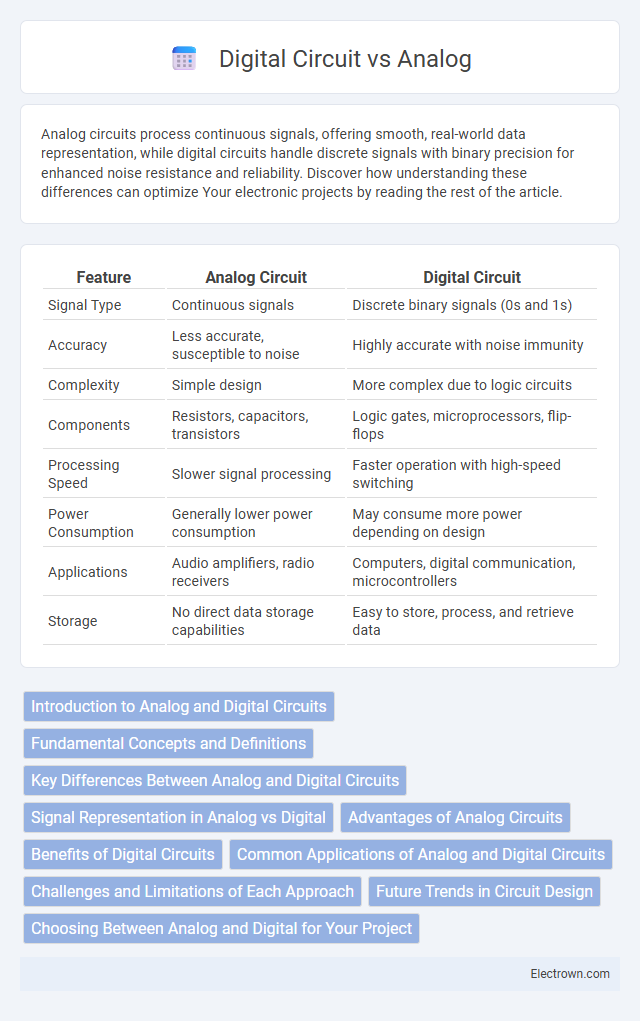Analog circuits process continuous signals, offering smooth, real-world data representation, while digital circuits handle discrete signals with binary precision for enhanced noise resistance and reliability. Discover how understanding these differences can optimize Your electronic projects by reading the rest of the article.
Table of Comparison
| Feature | Analog Circuit | Digital Circuit |
|---|---|---|
| Signal Type | Continuous signals | Discrete binary signals (0s and 1s) |
| Accuracy | Less accurate, susceptible to noise | Highly accurate with noise immunity |
| Complexity | Simple design | More complex due to logic circuits |
| Components | Resistors, capacitors, transistors | Logic gates, microprocessors, flip-flops |
| Processing Speed | Slower signal processing | Faster operation with high-speed switching |
| Power Consumption | Generally lower power consumption | May consume more power depending on design |
| Applications | Audio amplifiers, radio receivers | Computers, digital communication, microcontrollers |
| Storage | No direct data storage capabilities | Easy to store, process, and retrieve data |
Introduction to Analog and Digital Circuits
Analog circuits process continuous signals that vary smoothly over time, representing real-world phenomena such as sound, light, and temperature. Digital circuits manipulate discrete binary signals, using logic gates and flip-flops to perform computations and data storage. Understanding the fundamental differences between analog's continuous signal processing and digital's binary operations is essential for designing efficient electronic systems.
Fundamental Concepts and Definitions
Analog circuits process continuous signals, representing varying amplitudes over time, essential for applications such as audio amplification and sensor interfacing. Digital circuits handle discrete signals, encoding information as binary values (0s and 1s), enabling reliable data processing and storage in computers and communication devices. Understanding these fundamental concepts helps you design efficient systems by choosing between precision in analog or versatility in digital signal handling.
Key Differences Between Analog and Digital Circuits
Analog circuits process continuous signals that vary in amplitude and frequency, whereas digital circuits handle discrete signals represented by binary values (0s and 1s). Analog circuits excel in applications requiring smooth signal variations, such as audio and radio frequency processing, while digital circuits offer advantages in precision, noise resistance, and ease of data manipulation. Your choice between analog and digital circuits depends on the specific performance requirements and complexity of the electronic system involved.
Signal Representation in Analog vs Digital
Analog circuits represent signals as continuous waveforms, capturing every subtle variation in amplitude and frequency, which makes them ideal for audio and sensor data. Digital circuits convert signals into discrete binary values, providing greater noise immunity and easier signal processing through logic gates and microcontrollers. Your choice between analog and digital signal representation affects accuracy, complexity, and compatibility with modern electronic systems.
Advantages of Analog Circuits
Analog circuits offer superior signal resolution and continuous data representation, making them ideal for audio processing and sensor applications where precision is crucial. They consume less power and provide simpler designs for functions like amplification and filtering compared to their digital counterparts. You benefit from their real-time responsiveness and lower latency, which are essential in many control systems and communication devices.
Benefits of Digital Circuits
Digital circuits offer superior noise immunity compared to analog circuits, ensuring reliable performance in complex environments. They enable precise data processing and easy integration with microprocessors and memory devices, facilitating advanced computing applications. Digital circuits also provide enhanced scalability and reproducibility due to standardized logic levels and modular design approaches.
Common Applications of Analog and Digital Circuits
Analog circuits are widely used in audio amplification, radio frequency transmission, and sensor signal processing, where continuous signal variations are essential. Digital circuits dominate computing devices, data storage, and digital communication systems, enabling precise control and error correction through binary logic operations. Both analog and digital circuits complement each other in mixed-signal applications such as ADCs (Analog-to-Digital Converters) and DACs (Digital-to-Analog Converters) found in modern electronics.
Challenges and Limitations of Each Approach
Analog circuits face challenges such as susceptibility to noise, signal degradation, and temperature variations that impact accuracy and reliability. Digital circuits, while resistant to noise and capable of complex processing, encounter limitations in power consumption, switching speed constraints, and increased design complexity for high-frequency applications. Both approaches struggle with scalability issues, where analog circuits often require custom tuning and digital circuits demand more resources as integration density increases.
Future Trends in Circuit Design
Future trends in circuit design emphasize the integration of analog and digital components to leverage the strengths of both, improving performance and energy efficiency in emerging technologies like IoT and AI. Advances in mixed-signal ICs enable higher precision and faster processing speeds, particularly in applications requiring real-time data conversion and sensor interfacing. Development of neuromorphic and quantum circuits further drives innovation, pushing the boundaries of traditional analog and digital design paradigms.
Choosing Between Analog and Digital for Your Project
Selecting between analog and digital circuits depends on your project's requirements for signal fidelity and processing complexity. Analog circuits excel in handling continuous signals with high precision, ideal for audio or sensor applications where subtle variations matter. Digital circuits offer noise immunity and easier integration with microcontrollers, making them better suited for complex logical operations and automation tasks.
Analog vs Digital Circuit Infographic

 electrown.com
electrown.com